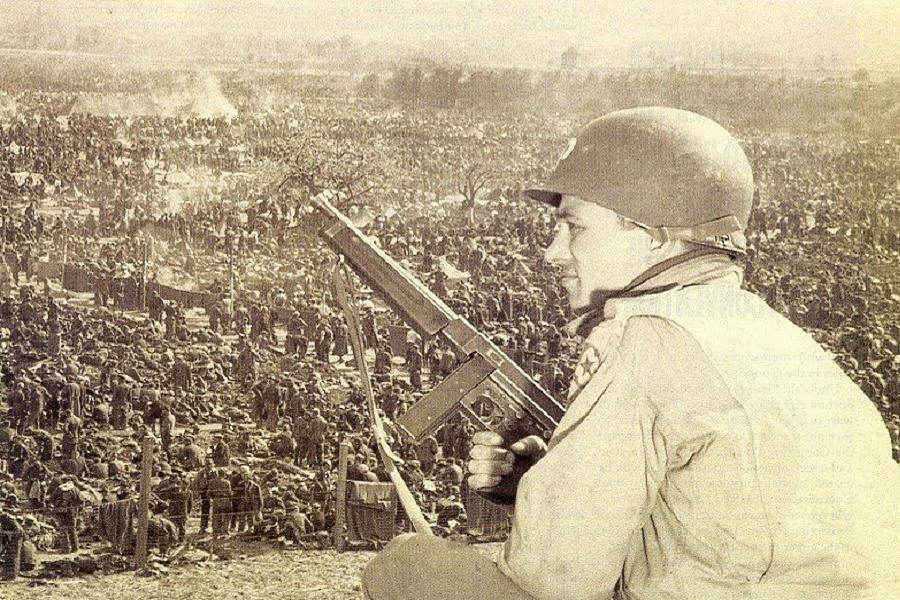A U.S. soldier at Camp Remagen, one of the Rheinwiesenlager camps, guarding thousands of German soldiers captured in the Ruhr area in April 1945.
By Richard Stockton Published January 13, 2017 Updated July 20, 2017
source:
https://allthatsinteresting.com/rheinwiesenlager
At the end of World War II, the U.S. opened camps of its own, where perhaps a million German prisoners died in secret.
Every schoolchild knows that the German side in World War II falsely imprisoned millions of noncombatants in a constellation of concentration camps scattered across the Nazi sphere of influence in Europe. Conditions in these camps were inhumane, to say the least, fraught with starvation, disease, and deliberate murder stalking every inmate for the months or years they spent interned.
What has largely escaped the victors’ history books, however, is that another program of internment and mass murder was put together at the end of the war by Allied forces, who took in millions of German prisoners in the summer of 1945 and deliberately starved roughly one in four of them to death.
The story of the Rheinwiesenlager, or “Rhine Camps,” was then covered up and obfuscated by professional historians for decades after the war while the survivors grew old and the prisoner records were destroyed.
Rheinwiesenlager: Last Moves Of A Lost War
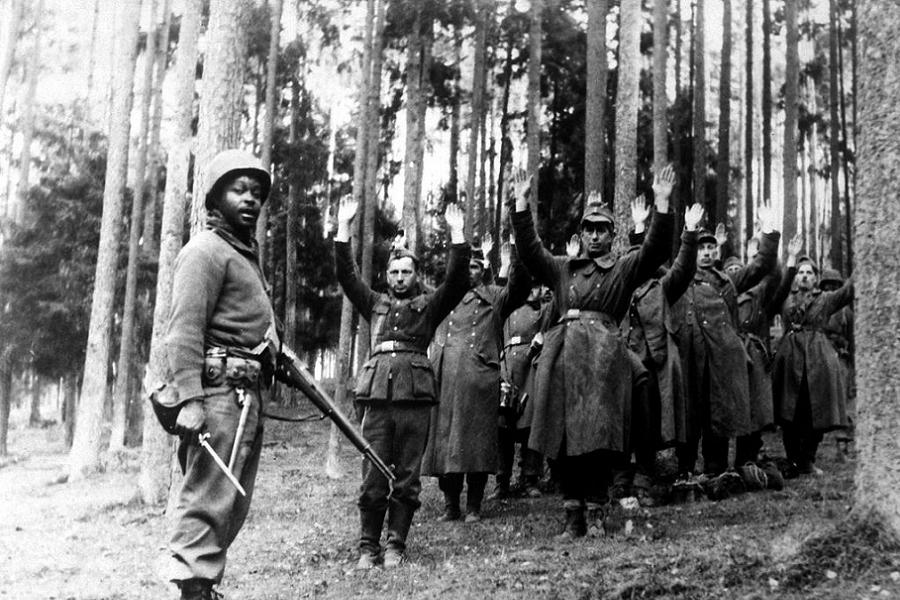
Flickr/ArmyDiversity
In the spring of 1945, the handwriting was on the wall for Germany. Millions of Allied troops poured into the Rhineland from the west, while the German SS and Wehrmacht forces staged desperate last stand actions in Vienna and Berlin to slow the Soviet Red Army’s advance in the east.
During this collapse, as German General Jodl stalled ceasefire negotiations to buy time, as many as three million German soldiers disengaged from the Eastern Front and trekked across Germany to surrender to American or British troops, whom they hoped would be less vengeful than the triumphant Soviets.
The German influx quickly grew so large that the British stopped accepting prisoners, citing logistical problems. Sensing that the Germans were turning themselves in en masse simply to delay an official, inevitable total German surrender, U.S. General Eisenhower then threatened to order his troops to shoot the surrendering German soldiers on sight, which forced Jodl to formally surrender on May 8.
The prisoners kept streaming in, however, and they all needed to be processed before the U.S. Army decided their fate.
The Army then hit on a solution for coping with large numbers of undesirable people that was similar to the one that the Germans had used in Poland: commandeer large stretches of farmland and wrap barbed wire around the prisoners until something could be sorted out.
Dozens of large holding camps thus sprang up in western Germany during the late spring of 1945, and by early summer, German prisoners of war still wearing their worn-out uniforms began to fill them.
Army officers skimmed off suspicious-looking prisoners, such as SS personnel and men with blood group tattoos on their arms (often a sign of SS membership) and sent them to intelligence officers and war crimes investigators for special scrutiny.
Meanwhile, officers allowed rank-and-file members of the Wehrmacht, Luftwaffe, and Kriegsmarine to simply pick a spot on the ground and sit down until somebody up the chain decided they could go home. Or so they thought.
A New Status For Prisoners
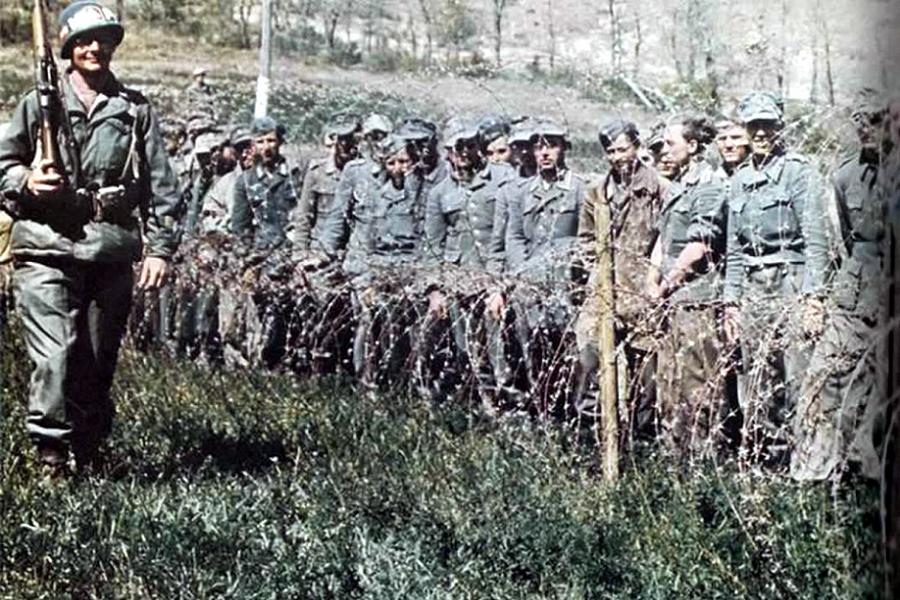
Wikimedia Commons
The Geneva Convention and the 1907 Hague Convention strictly regulate the treatment of wartime prisoners. Captured enemy soldiers cannot be tortured or executed if they were wearing their country’s uniform when caught. They cannot be put on display or publicly humiliated, nor can they be overworked or punished for no reason.
The conventions are stringent about their provisions: Every single POW must be fed and housed up to a standard equal to what their guards get, for example. And if it is impractical to heat the prisoners’ barracks, for instance, the conventions’ rules say that the camp personnel should not have heated barracks, either.
Almost uniquely for WWII powers, the American Army took these rules seriously and even, at one POW camp, made its own guards sleep in bedrolls on the ground for the three days it took to build prisoner barracks, though their cabins were already finished.
This American reputation for fairness drew millions of defeated Germans to the Western Front in the first place, and probably shortened the war somewhat as the fighting men chose captivity over suicide in battle.
What none of the surrendering Germans knew was that General Eisenhower, in consultation with British Prime Minister Winston Churchill and President Franklin Roosevelt in 1943, had already decided to use the inevitable German weakness following defeat to permanently cripple that country’s ability to wage war.
As early as 1943, at the Tehran Conference, Roosevelt and Stalin had famously toasted to the shooting of 50,000 German officers after the war. They may or may not have been serious, but early in 1944, Eisenhower appointed a special assistant named Everett Hughes to handle the details of the surrender. That summer, a postwar plan devised by Treasury Secretary Henry Morgenthau, Jr. was initialed (and presumably approved) by both Roosevelt and Churchill.
The Morgenthau Plan, as it came to be known, was beyond punitive: Germany was to be divided into occupation zones, its industry destroyed, crushing reparations imposed, and large sections of its population forcibly resettled to wipe out the German capacity for war once and for all.
It was, by modern standards, practically a blueprint for national genocide insofar as millions of Germans would have to starve or relocate to make it work.
Everett Hughes was all in favor of the Morgenthau Plan, but after the PR disaster that followed the October release of some of the details, he was cautious. On November 4, Hughes sent a memo to Eisenhower urging him to classify details of prisoners’ rations as top secret. Eisenhower agreed.
“Widespread Mistreatment”
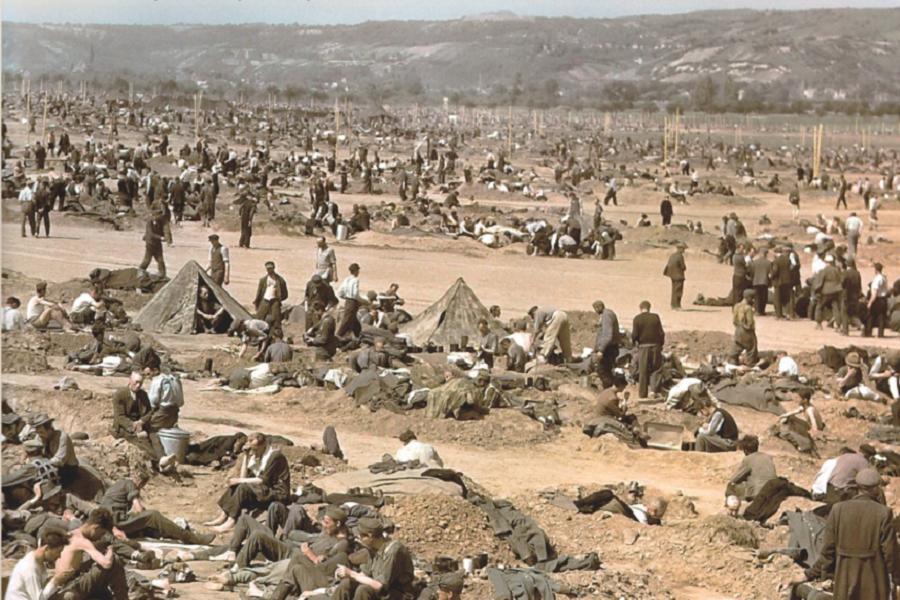
Wikimedia Commons
Millions of surrendered Germans were held under conditions the U.S. Attorney General compared to Andersonville, the notorious Civil War Confederate POW camp whose commandant was hung for war crimes.
The reason for Hughes’ interest in rations lies in the legal distinction he and others on Eisenhower’s staff had made. Surrendered Germans, they decided, would not be classed as POWs, but under a new and totally made-up designation of “disarmed enemy forces” (DEFs). As DEFs, rather than POWs, the men would be entitled to none of the Geneva Convention’s protections.
The American forces would not even be obliged to feed their captives, and they could legally — so went the argument — bar the Red Cross from inspecting their Rheinwiesenlager camps or sending relief aid.
Under their new legal status, the defeated German soldiers would almost literally become unpersons, a vulnerable position compounded by the fact that after the surviving German statesmen were arrested in Flensburg, German veterans didn’t even have a government to advocate for them anymore. They were perfectly helpless and totally at the mercy of the U.S. Army.
There is only one reason to strip prisoners of war of the legal status that protects them from mistreatment: to mistreat them. According to a 1989 book on the subject, Other Losses, by Canadian writer James Bacque, at least 800,000, and “quite likely over a million” prisoners lost their lives in American-operated Rheinwiesenlager camps during the summer and fall of 1945.
Conditions in the Rheinwiesenlager camps, which were later reviewed by the Surgeon General’s Office, “resembled Andersonville Prison in 1864.” Even Stephen Ambrose, the world-famous historian and sometimes-employee of the Eisenhower estate, who was hired by the late President’s family to investigate the book’s charges, admitted in a 1991 New York Times article:
“There was widespread mistreatment of German prisoners in the spring and summer of 1945. Men were beaten, denied water, forced to live in open camps without shelter, given inadequate food rations and inadequate medical care. Their mail was withheld. In some cases prisoners made a “soup” of water and grass in order to deal with their hunger. Men did die needlessly and inexcusably.”
Denial and Subversion
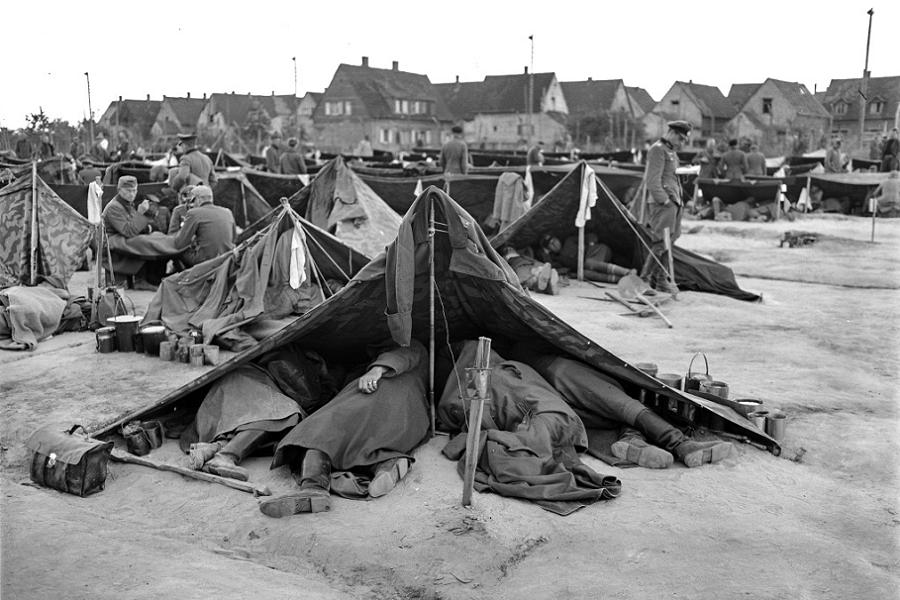
Wikimedia Commons
Conditions varied at each camp, but dugout shelters covered with clothing and scraps of cloth were typical in the crowded makeshift enclosures.
The unpleasant details Ambrose would admit about the Rheinwiesenlager camps barely scratch the surface.
Allied forces would usually strip search and interrogate men designated as DEFs before admitting them to the camps. Much of the time, the American or British officers conducting the interrogations staged them to make the German (who was usually tired and hungry, deprived of sleep and wholly ignorant of the American and British justice systems) think he was on trial for his life and could only save himself or his family by confessing to whatever crimes he was being asked about.
Official marched the vast majority into barbed-wire enclosures and abandoned them — prisoners rarely received food or water, let alone fresh clothes, and shelter was whatever size hole they could dig with their hands.
Men who approached the perimeter wire to beg for provisions ran the risk of being shot as attempted escapees, but those who didn’t could easily starve to death or die of the typhus, cholera, and other illnesses endemic to the Rheinwiesenlager camps.
Both the International Committee of the Red Cross (ICRC) and German civilians (short on food themselves) sent what aid they could. Still, camp officials flatly refused the ICRC entry to the camps and told them the DEFs had plenty of food without their help.
Nobody seems to know what happened to the civilian food parcels, though the guards never reported food shortages themselves, and it’s possible some parcels were distributed to French civilians near the border. The men in the camps got nothing, and soon they began to die.
No known, existing records show exactly how many German veterans died in the Rheinwiesenlager camps. The Army claimed after the war that it was impossible to track millions of prisoners under those conditions, and thus said that no detailed paperwork was even attempted. Later revelations showed that in fact the Army did keep files on the men, but that around 8 million documents were destroyed after the camps closed.
The closest researchers can get is in the “Other Losses” column of the Army’s records, showing discrepancies in the weekly prisoner count of sometimes tens of thousands of men who vanished from one head count to the next. This miscellaneous column, which gave Bacque the title of his book, excluded releases and escapes, as well as the majority of prisoner transfers, so no official explanation exists as to where hundreds of thousands of DEFs went during the months that the Rheinwiesenlager camps were operating.
Ambrose’s team issued a scathing indictment of Bacque’s work, asking in what they thought was a rhetorical tone where those million dead bodies went, since it’s presumably difficult to hide seven-figure death tolls in the Rhineland.
Nobody knows for sure what the answer to that question is, even today, but since 1945 the French and German governments have enforced a blanket ban on excavations across large swathes of their border territories where the camps were located.
The U.S. Army occupation forces established these exclusion zones at the end of the war, used them for “unknown” purposes throughout 1945, and then restricted them forevermore as war graves. No one is allowed to dig in these areas, and it seems no one ever has, so it is possible that the answer to the historians’ question lies buried under the trees of the Rhine River Valley to this day.
Fascinated by this look at the Rheinwiesenlager? Brush up on more (often covered up) history with our posts on the worst war crimes and Leopold II’s Congo genocide that no one talks about.
